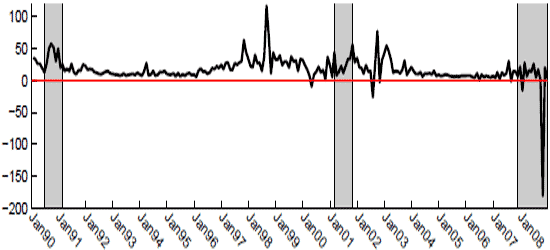Does the gap between the (sentiment-driven?) options-implied volatility and the (data-driven) expected volatility of the broad equity market predict future stock returns? In the May 2009 version of his paper entitled “Variance Risk Premia, Asset Predictability Puzzles, and Macroeconomic Uncertainty”, Hao Zhou examines the predictive power of this gap based on several ways to derive expected volatility from realized volatility. Using monthly values of the Chicago Board of Options Exchange Volatility Index (VIX) to calculate implied volatility and high-frequency intraday S&P 500 Index levels to calculate realized volatility over the period 1990-2008, along with contemporaneous data for traditional market predictors, he concludes that:
- The gap between implied and expected volatilities (the variance or volatility risk premium) relates significantly and positively to short-term future equity returns and bond returns.
- Predictive power is strongest at forecast horizons of one to three months (with adjusted R-squared statistics indicating explanatory power of a few percent), and then diminishes as forecasting horizon increases.
- This short-term return predictability complements the long-term forecasting power of price-to-earnings ratio and interest rates such that combining the volatility risk premium with these indicators enhances overall predictive power.
The following figure, taken from the paper, plots the volatility risk premium (gap between implied and expected volatilities) for the S&P 500 Index during 1990-2008 using lagged realized volatility as the expected volatility. Shaded areas indicate NBER recessions. This gap is relatively large during the 1990 and 2001 recessions and very large during the 1997-1998 Asia-Russia-Long-Term Capital Management crises and 2002-2003 corporate accounting scandals. The extreme dip in the volatility risk premium during the current recession occurs in October 2008.
The paper offers several similar plots for alternative measures of the expected volatility of the S&P 500 Index.

In summary, evidence suggests that the fear-driven gap between option-implied volatility and contemporaneous realized volatility for a broad stock market index may offer investors/traders a small edge in anticipating near-term stock and bond returns.
Note that predictability significance measures in this study assume normality of asset return distributions (empirically disputable) and that statistical significance here translates into just a small (difficult to confirm in trading) edge for monthly trading.